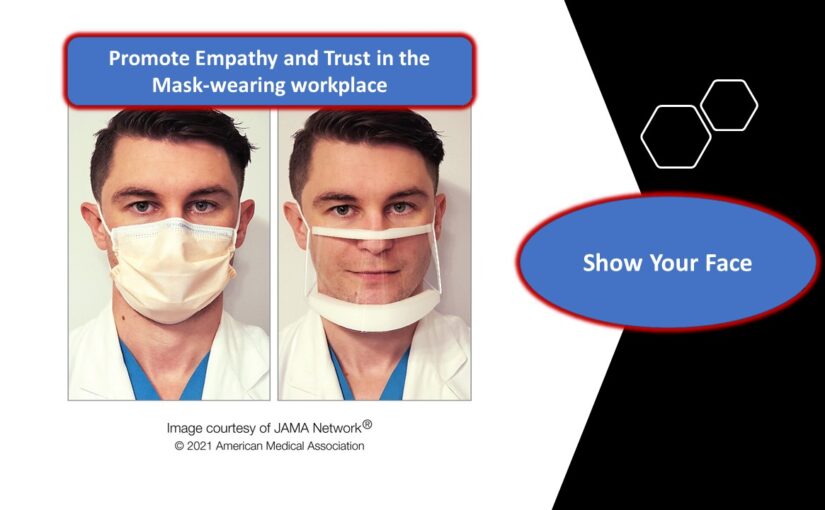By Thomas Davis, DNAP, MAE, CRNA
This article is not intended to make a political statement, pass judgement on the CDC, or coerce healthcare providers to do anything that would compromise their safety or that of their patients. Rather, the article is written to increase awareness about the negative effects of face covering when interacting with patients and to stimulate thought about creative ways to enhance connectedness while maintaining a safe environment.
The importance of emotional intelligence in both your personal and professional life was documented in a recent article published on prosynex.com. The article noted that emotional intelligence is built upon a foundation of trust and empathy, both requiring connectedness between two individuals. Development of those core elements is enhanced by being sensitive to verbal and non-verbal cues that are sent including tone of voice, body language and facial expressions. Barriers such as facemasks and personal protective equipment (PPE) inhibit sensing the full message that is being sent and negatively influences the development of trust, empathy, and connectedness between providers and patients.
Learning from the past
Over a decade ago, family practice physicians realized that they were constantly being exposed to every contagious organism in the community and opted to protect themselves by wearing facemasks when interacting with patients. In the ensuing months/years family practice patient satisfaction, trust and compliance scores dropped and many speculated an association between facemasks and the relationship between physicians and patients. A 2013 (pre-COVID) study done by Wong et al and published in BMC Family Practice found that a physician wearing a mask during a patient visit had a significant negative effect on the perception of the doctor’s empathy. The study demonstrated that when doctors wear facemasks during patient appointments, there is a decline in empathy and relational continuity.
Fast forward to today’s mask wearing COVID society and there is concern across the board about the negative effects of blocking non-verbal cues for the detection of feelings which affects the provider/patient relationship. Writing in Psychology Today, author Cara Goodwin PhD notes that infants only a few months old begin looking at the mouth for visual cues about emotions and we continue to assess facial cues throughout life. Her research demonstrated the wearing masks makes positive emotions seem less happy, thus making children less likely to perceive positive emotions from mask wearing adults.
In an article recorded in the National Library of Medicine, author Felix Grundmann explored the effects of mask wearing on the elderly population noting that we tend to deduct a stranger’s trustworthiness and likability from facial expressions. Remarking that neuron density and neurotransmitter changes in the elderly already impede the perception of emotions, the author found that mask wearing hides facial cues and makes the detection of emotions even more difficult for elderly patients.
Being mindful of the negative effects mask wearing on the physician/patient relationship, Kratzke, Rosenbaum, and Cox conducted a study published in JAMA Surgery, 2021, where clear, see-though masks were compared to traditional hospital masks when surgical residents interacted with patients. With the clear mask, facial expressions were visible and, as expected, those wearing transparent face covering were rated as being more understandable, empathetic, and trustworthy.
Improving provider/patient trust
Evidence-based medicine that predates COVID clearly demonstrates the wearing a mask while interacting with a patient has a negative effect on the provider/patient relationship. Addressing the issue begins with the awareness that you are already at a disadvantage for building trust solely due to the requirement to wear a mask. Therefore, being animated with eye and hand expressions will help the patient perceive your sincerity and mood. Assume that your voice is muffled by the mask so speak loudly and solicit feedback to ensure that you are understood. When possible, use a clear mask that reveals facial expressions.
Be COVID cautious and resist crossing the line to COVID crazy. If you are working in a COVID unit or other area with high risk for exposure, full PPE may be appropriate. However, if you are in a controlled environment where the risk for exposure is low, consider a plexiglass divider separating you from the patient and remove your mask during an interview. When it’s time for hands-on contact, put the mask back on. Ask your materials manager to order clear plastic facemasks for use when talking with the patient. If your patient is at low risk for having COVID, consider removing your mask and maintaining the recommended 6 feet of social distancing from your patient while doing an interview. However, if local protocol always requires the use of a traditional mask, speak loudly, have expressive eyes, and maintain an energetic, upbeat attitude. The COVID pandemic has created safety requirements that impede the ability to use emotional intelligence when interacting with patients. Be aware, be creative and develop a positive relationship with each patient.
Tom is an experienced leader, educator, author, and requested speaker. Click here for a video introduction to Tom’s talk topics.
